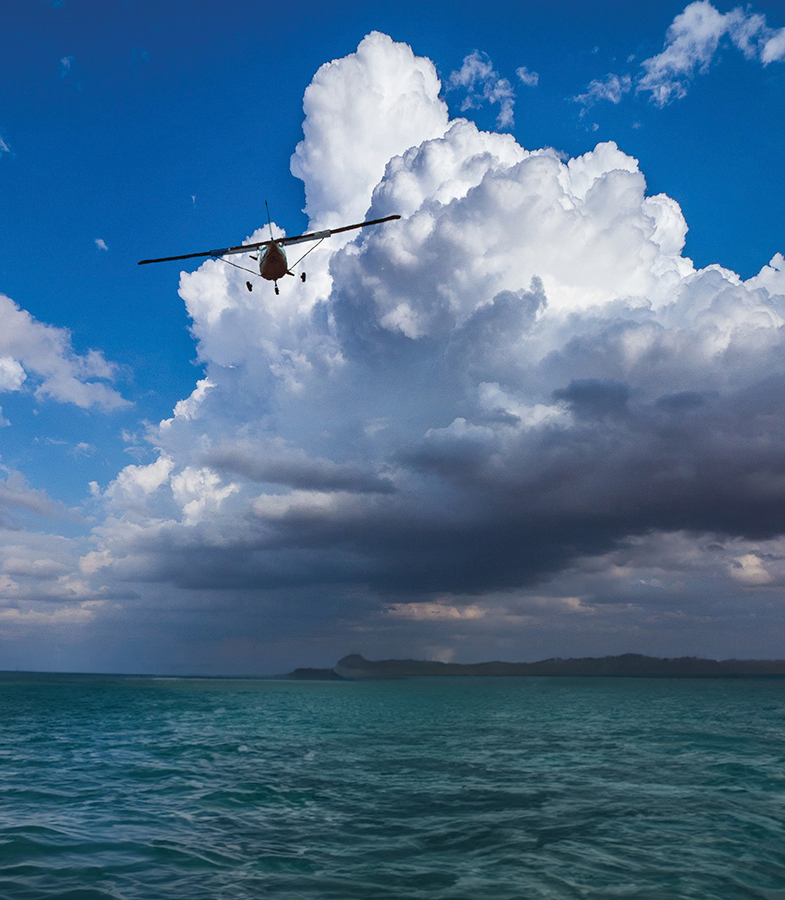The elements humble a newly qualified pilot.
I was a freshly minted CPL with the world at my feet, or so I thought.
After arriving in a coastal town located in Western Australia, I’d managed to score that illusive first job in aviation – flying charter and scenics. Emotions were understandably running high.
I’d been checked to line only 2 days prior and had already witnessed the aftermath of a botched landing attempt at one of the strips we fly to regularly, probably an early indicator of the unforgiving nature of the task at hand.
It was a simple flight, just 40 minutes to the island strip, drop the passengers off and then straight back to town empty, with an estimated landing time of 5:30 pm, about 45 minutes before last light.
The weather was relatively good too, some cloud up high and only a PROB30 INTER TSRA 3000 to contend with. How many times I’d seen this and thought nothing of it – a 30% chance a thunderstorm will roll through intermittently – so it can’t be that bad if it turns up at all.
Everything went perfectly on the way out, then a turnaround and I was back in the air heading for home around 5 pm. It wasn’t until around 5:20 pm when the first sign of apprehension set in as I noticed what appeared to be a small amount of towering cumulus off in the distance.
Within 5 minutes, the chief pilot was frantically calling me, about the only time in my career I’ve been thankful of this! This system had come from nowhere. A late afternoon thunderstorm had spawned inside of 10 minutes and the coastline in front of me was disappearing under a layer of cloud at no more than 1,000 feet AGL.
The chief pilot was giving me ground reports of what he was seeing and it wasn’t good. Heavy showers, low ceiling and reduced visibility over the airfield, no place for a VFR aircraft to be. At 20 nm from home, I could see I wasn’t going to make it straight in so I began to slow the aircraft to conserve fuel should I need it.
Surely, a hole would open up and I could just come in and land, I thought naively.
I began slowly heading north, about 10 nm off the coast, and waited for the weather to pass through, still considering this an INTER event. Surely, a hole would open up and I could just come in and land, I thought naively.
As any prudent pilot would, I used this time to start thinking of alternate plans that were within reach before last light became an issue. The problem was, by the time I thought to consider turning back to where I’d come from (time now 5:40 pm), arrival there would be about 10 minutes past sunset. There is no runway lighting at the island and this wasn’t a risk I wanted to take.
If the storm began moving over the water, I would be stranded and forced to land at a relatively unfamiliar, short dirt strip in the dark. All of a sudden, my best option 5 minutes ago is no longer a good idea.
As I was distracted talking to the chief pilot, then faffing around pulling out my WAC chart from under my seat, then looking for all those small purple circles dotted along the countryside, my distracted self began drifting closer to the storm.
Then the turbulence hit. The WAC chart became unreadable as my head now bounced off the ceiling, knocking my headset off. I’d managed to spot something on the WAC chart and knew it was about 30 nm to the north of town. The storm was moving south-west, so getting to the north of it was the safest option.
After frantically calling the chief pilot again, he managed to send me a drop pin of the strip on Google Maps, as I headed further offshore to escape the brutal turbulence.
I managed to scud run north following the coastline, just below the cloud ceiling at 800 feet and, for a moment, things seemed to be going better. I finally had visual on the northern edge of the storm, the GPS location on my phone and a dropped pin I was tracking towards.
When I approached the strip, I was in luck – it was in clear skies by a margin no greater than 2 nm. It was hard to spot the dirt strip, it hadn’t been used in months and a quick strip inspection deemed it adequate for landing. As I wasn’t going anywhere else at this stage, I’d need to see a boulder in the middle of the strip to convince me otherwise.
With the sun dipping below the horizon, I touched down with one of the worst landings that poor Cessna had ever experienced. Turns out when you make it overhead the field after a stressful situation, you can’t just switch off and think, ‘Gee, I made it!’.
After rolling to a stop and parking the aircraft, I couldn’t help but notice the ground was wet, the storm had just rolled through. The realisation hit – if I wasn’t able to get in there, the only airstrip further north was another 20 minutes away, right on last light. No night rating in a day VFR aircraft – that surely would have tested the abilities of this hotshot fresh CPL.
It took a few hours to get a vehicle out to collect me and I was able to take that time to realise just how lucky I’d been. I discovered 41 mm of rain fell in 1.5 hours over the town, pretty impressive for PROB30 INTER I must say.
Lessons learnt
I was not prepared. Combine that with the arrogance of passing your CPL flight test and line check 2 weeks earlier, was a recipe for disaster.
I pulled out the WAC chart too late and couldn’t get any lead-in features to the airstrip while it jiggled in my hands. I’d never considered the possibility the weather could turn like it did that day, the speed at which it formed was astounding.
Also, the hard landing was a textbook human factors case of switching off after a highly stressful situation. It’s fair to say nowadays I’ve got an ‘escape plan’ for whenever I go flying, regardless.
Which way is the wind going? What airstrips are near my escape plan track and what landmarks are nearby to easily locate them? An idea I’ve since heard about is to visualise a circle around your current position. Fuel, last light and any other factor limit the radius of that circle, which is determined by time multiplied by ground speed. As your circle starts reducing in size, your options may start falling outside the circle. 
If the storm began moving over the water, I would be stranded and forced to land at a relatively unfamiliar, short dirt strip in the dark.
Weather and forecasting is one of the special topics on our Pilot safety hub.
Have you had a close call?
8 in 10 pilots say they learn best from other pilots and your narrow escape can be a valuable lesson.
We invite you to share your experience to help us improve aviation safety, whatever your role. You may be eligible for a free gift just for submitting your story.
Find out more and share your close call here.
Disclaimer
Close calls are contributed by readers like you. They are someone’s account of a real-life experience. We publish close calls so others can learn positive lessons from their stories, and to stimulate discussion. We do our best to verify the information but cannot guarantee it is free of mistakes or errors.




